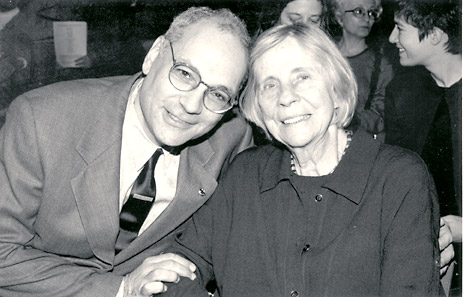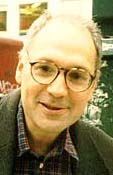Charles Bernstein
Composing Herself: Barbara Guest
See also  Charles Bernstein Introduces Barbara Guest, April 23, 1999, in Jacket 10.
Charles Bernstein Introduces Barbara Guest, April 23, 1999, in Jacket 10.
This piece was first published in Bookforum (April/May issue). It is 1,000 words or about 2 printed pages long.
The last time I saw Guest at a public event was at a 1999 Barnard poetry conference entitled "Where Lyric Tradition Meets Language Poetry: Innovation in Contemporary American Poetry by Women.” Guest told a packed crowd that had come to honor her that she had come to her session unprepared. Her comment was a classic instance both of her reserve and her poetics. For fifty years, Barbara Guest gave us a poetry for we were unprepared, a poetry that tested the limits of form and stretched the bounds of beauty by revisioning—both revisiting and recasting—the aesthetic.
Guest, who was born in 1920, died in Berkeley on the day after St. Valentine’s Day, 2006; she was a poet at all times close to, yet decisively out of synch with, the rites of lyric voicing. Indeed, her work, more than any other poets of her generation, enacted a “lyric negation,” as critic Robert Kaufman has noted, singularly inhabiting and disavowing poetry’s ability to mime personal utterance. Guest’s unsparing aestheticizing created a new horizon for alyric verse in which saying cedes seeing, composition concatenates context, and palette elides figuration. For these reasons, she is the direct heir to Hopkins’s sprung rhythm and to the idea of imagination that she found in Coleridge and Stevens.

Charles Bernstein, Barbara Guest, photo by Star Black, 1999
I take Guest’s aversion to the lyric to mean that her work is not an extension of herself—herself expressed—that is, not a direct expression of her feelings or subjectivity, but rather is defined by the textual composition of an aesthetic space—herself (itself) defined. And while I would not call her Objectivist (or, in the parlance of another media, “nonobjective”), I think the link is there, both to the American Objectivist poets and to nonobjective painting.
Guest’s first book of poetry, The Location of Things, was published in 1960 by the Tibor de Nagy Gallery, when she was forty. Like Stevens, a poet with whom she felt a close affinity, Guest arrived on the scene with total command and startling freshness. She had met Frank O’Hara and James Schuyler in the ’50s when she was writing reviews for Art News. Many of these reviews, along with a selection of later essays and poems on art, were collected three years ago in Dürer in the Window, Reflections on Art (Roof Books, 2003), edited by Africa Wayne and sumptuously designed by Richard Tuttle. An important related book is her collected essays on poetics, Forces of Imagination: Writing on Writing (Kelsey Street Press, 2003). In all, Guest published twenty books of poetry, twelve in the last two decades of her life, this prolific late period inaugurated by Sun & Moon’s publication of Fair Realism in 1989 and continuing through Wesleyan University Press’s publication of The Red Gaze last year. Guest also published one of the great poet’s novels, Seeking Air (Black Sparrow Press, 1978; reprint, Los Angeles: Sun & Moon Press, 1997) and a biography, Herself Defined: The Poet H.D. and Her World (Doubleday, 1984).
While often associated with O’Hara, Schuyler, and Ashbery, aka The New York School, a remark Guest makes in an essay on Helen Frankenthaler’s relation to the painters with whom she is usually grouped applies to Guest as well: “her eyes focused differently.” Indeed, the distinctiveness of her work is better understood if a comparison is made to Frankenthaler and to another painter Guest much admired, Joan Mitchell. The writer’s aesthetic, which becomes ever more apparent in her later work, is well expressed in a comment she makes on Frankenthaler’s process: “The moment the brush touches down, the painter is free to explore. The brush carries the momentum as the artist explores the moment—moment and momentum are the springboard . . . The moment now becomes the distance.”
Guest’s insistence on detachment, as she calls it, or let’s just say her restrained elegance, is exemplified in her attraction to lapidary surfaces that set her apart from many of the most innovative “New American” poets of the ’60s, with their various projections of spontaneity, insouciant informality, the visceral, camp irony, or pop inflection. These same “distances” made her even more unavailable to Official Verse Culture, exemplified, as Linda Kinnehan has noted, in James Dickey’s Kenyon Review response to Guest’s first trade book, which was published by Doubleday in 1962: “Miss Guest,” Dickey assures us, “abolishes relationship, and consequently abolishes value.” If we take Dickey’s comment as a declaration of Guest’s—and by extension American poetry’s—independence, then we might say that in her late, Fair Realism and Defensive Rapture (Sun & Moon, 1993), she fulfills the promise of The Tennis Court Oath, Ashbery’s most explicitly disjunctive book, published in 1962, a work that points to the lyric negation that became central for Guest’s poetry.
No ideas only surfaces, no surfaces only words, no words only textures, no textures only contingent connections . . . The proofs of poetry often take a long time to develop. If affinity is any measure, Guest’s shadow graces poets as accomplished and different as Rachel DuPlessis, Charles North, Elizabeth Willis, Susan Howe, Douglas Messerli, Kathleen Fraser, Peter Gizzi, Ann Lauterbach, Rosmarie Waldrop, Norma Cole, Cole Swenson, Michael Palmer, and Mei-mei Berssenbrugge.
In a period of American poetry in which the most visible and indeed much of the very best poetry has been written with hooks galore—whether outrageous or flamboyant or hip or morally uplifting, the arrogant or agonized or transcendent—Guest used no hooks. This allowed her to create a textually saturated poetry that embodies the transient, the ephemeral, the flickering in translucent surfaces that we call painterly for lack of a term to chart the refusal of a pseudo-depth of field. It would be easy to dwell on the exquisite surface refraction in Guest’s work while eliding the significance of this insistently modulated diffusion and liminal warping and woofing.
In his prescient review, Dickey admonished the new poets: “They expect the reader to work devotedly for them to solve conundrums, to supply transitions, to make, out of a haphazard assortment of building materials, a habitable dwelling.”
Guest never fit in to our pre-made categories, our expectations, our explanations. She wrote her work as the world inscribes itself, processually, without undue obligation to expectation. These poems unravel before us so that we may revel in them, find for ourselves, if we go unprepared, the dwelling that they beckon us to inhabit.

Charles Bernstein’s most recent book is Shadowtime (Green Integer), the libretto for an opera with music by Brian Ferneyhough, presented by Lincoln Center Festival in July 2005. Photo: Charles Bernstein, New York, November 1997. Photo by John Tranter.
it is made available here without charge for personal use only, and it may not be
stored, displayed, published, reproduced, or used for any other purpose
This material is copyright © \z and Jacket magazine 2006
The Internet address of this page is
http://jacketmagazine.com/29/\z .html
